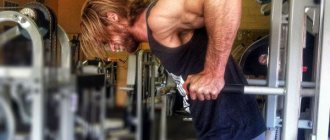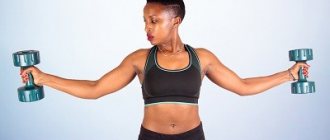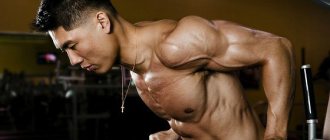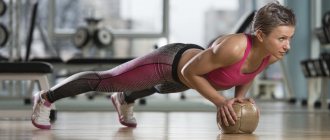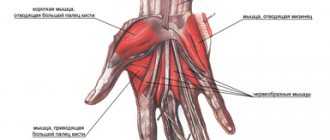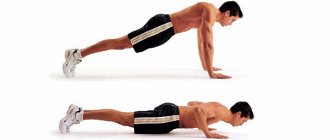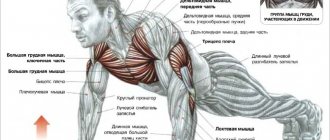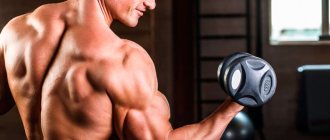The horizontal bar is considered an effective tool for developing several muscle groups at once.
The main emphasis of the load falls on the back, but with its help it is quite possible to pump up your arms, shoulders and abs.
There are several exercises that will help you achieve your goal or allow you to diversify your training process.
With the help of a horizontal bar you can develop not only your back, but also your arms. Moreover, we are talking not only about the biceps, for the development of which there is a separate exercise on the bar, but also the triceps, as well as the forearms.
How can you pump up your arm muscles on the bar?
The load on the forearm also occurs when performing any exercises on the bar.
These can be both classic pull-ups and more complex ones, for example, static elements, when an athlete holds the weight of his body, fixing it perpendicular to the rack of the apparatus, that is, providing a static load.
It’s also possible to pump up your biceps. To do this, you need to use a reverse grip and place your hands close to each other. In this position, it is the biceps that will receive the maximum load, especially its outer part.
Important! Classic pull-ups place more stress on the shoulders and back. Additionally, the load falls on the triceps; it can be strengthened with the help of auxiliary movements without a horizontal bar, for example, push-ups with a narrow grip or reverse push-ups.
Be sure to check out:
Swinging on the uneven bars and horizontal bar: an effective training program Pull-up program on the bar: technical nuances and tips Pull-ups on the horizontal bar for the health and beauty of the body Pull-ups on the horizontal bar: what muscles work
How to learn to do dips
Strengthening exercises will help you strengthen your muscles and get used to the correct movements. Choose one that suits your fitness level and do it 3-4 times a week, with a one-day break between workouts. Do 5 sets of 8-10 reps.
Reverse push-ups
Unlike the parallel bars exercise, reverse push-ups have your feet on the floor, making them easier to perform. However, this puts more strain on the shoulders because the elbows are bent behind the back rather than at the sides of the body.
To protect your shoulders, turn your wrists out to the sides. This will limit your range of motion and protect your joints from hyperextension.
Make sure that your body moves close to the support; at the top point, do not lift your shoulders towards your ears.
When these push-ups become easy for you, move on to the next option.
Reverse push-ups with legs raised
Place your legs straight on a raised platform. You can start with a small stand and gradually increase the height. The higher the stand, the more difficult the exercise.
The rules of execution are the same: at the top point, lower your shoulders, try to move close to the support.
Push-ups with an expander band
This exercise exactly repeats the classic dips, but the elastic expander under your feet pushes upward and relieves some of the load.
Select the resistance of the expander so that you can perform 8-10 reps per set. As you pump up your muscles, change the tape to a thinner one.
Eccentric dips
If you don't have an expander band, try the eccentric version. Jump onto the bars and lower yourself down as slowly as possible.
When the muscles get stronger, switch to the classic version of dips, but watch the technique. It’s better to do less, but correctly, than to spread your elbows and jerk your legs, trying to push yourself up.
A set of the best exercises for all muscle groups
There are many horizontal bar exercises that horizontal bar lifters should include in their routines. These are basic exercises, like pull-ups, as well as more complex ones that require special training:
| Pull-ups | Classic pull-ups are performed with a straight grip, when the hands hold the horizontal bar from above. The grip is either medium or wide. The body rises up without swinging or jerking, and falls slowly. At the top point you can take a short break. The exercise loads the upper back and its middle, as well as the shoulders. A small load falls on the triceps. |
| Head pull-ups | Pull-ups are performed in the same way as classic ones, only the head goes behind the horizontal bar in the top position. In this position, the load shifts to the upper back and trapezius. |
| Reverse grip pull-ups | They are performed exactly the same as the standard version, but the hands are either as close to each other as possible, or an average grip width is used. Also, the palms need to be turned, that is, a reverse grip is used. The load is shifted to the biceps and forearms. |
| Exercise corner | This exercise allows you to pump up your abs. You need to hang on the horizontal bar and raise your legs to ninety degrees. At the top point, you can stop for a second or two, that is, take a break. |
| One arm pull-ups | They are performed only by trained athletes, as they require significant skills. You can start by hanging on one hand, clasping your wrist with the other. The exercise develops the shoulders, arms and forearm. |
| Vis | A static exercise that is required to develop endurance, as well as to strengthen the wrist and forearm. You can hang by grasping the horizontal bar with your hand or holding it with several fingers. |
These are just the most popular exercises; the training program may consist of other movements. The ones listed are included by beginners in order to maximally load the main muscle groups.
As for training your legs, it’s worth noting that you won’t be able to fully pump them up on the horizontal bar. It is necessary to include other movements, such as jumping and squats.
Options for lesson plans
The training program on the horizontal bar can be quite varied. An athlete can pump up almost all muscle groups with the help of a projectile, with the exception of the legs and buttocks.
A beginner's training plan might look like this:
- pull-ups with a medium grip, 4 sets of 12 repetitions (if you can’t do 12, you need to do it to the maximum);
- head pull-ups, 3 x 10;
- biceps pull-ups, that is, with a reverse grip, 3 to 10;
- hang, 3 times for maximum time;
- corner, 4 to maximum. If the exercise is difficult, you can raise your legs with your knees bent.
Training can include more than just exercises on the horizontal bar. It is useful to include other movements:
- running, 15 minutes;
- squats, 4 sets of 15 reps;
- head pull-ups, 4 x 12;
- biceps pull-ups, 3 x 10;
- push-ups, 4 to 15;
- lying crunches.
The training program should be varied. It is best to alternate movements for different muscle groups every day, especially if the goal is to increase muscle mass. The muscles must have time to recover, otherwise they will not be able to be included in full work next time.
For example, one day you can train only your legs, on another day you can devote time to the horizontal bar and work on your back and shoulders, and on the third day you can do more push-ups, pumping up your arms and chest.
Important! When exercising on the horizontal bar, you should also not forget about the progression of the load. The complexity of the training must increase from time to time, otherwise there can be no talk of progress. One option is to constantly increase the number of repetitions, but for increasing mass this method is only suitable up to a certain point.
The best time to start using weights is when doing 12 pull-ups for multiple sets becomes easy. This could be a backpack, leg weights, a belt with a fixed weight, and so on. This method is suitable for regular pull-ups and their various variations.
You can also complicate a program by including new elements into it. For example, one-arm pull-ups after completely mastering the usual ones, the use of special “handles” that change the emphasis of the load, and so on. You can also do paused pull-ups, negative reps, etc.
Execution technique
To perform triceps-focused push-ups, you will need parallel bars that are slightly wider than your shoulders apart.
- Take the starting position - emphasis on the uneven bars with straight arms. The body should be in a vertical position, i.e. there is no need to lean forward. Bend your legs, you can cross them - whatever is more convenient for you. Do not sag in your shoulders, your back and neck are straight, your gaze is directed forward.
- As you inhale, slowly lower yourself down. At the same time, move your elbows back. Try to maintain as upright a body position as possible. The front of the shoulder will noticeably stretch as it moves down. Avoid pain in this area. As a rule, it is recommended to bend your arms to a right angle, however, everything is individual here. The greater the amplitude, the higher the load not only on the muscles, but also on the joints.
- As you exhale, straining your triceps as much as possible, rise to the starting position. Repeat the exercise.
To gain weight and increase the volume of your arms, it is recommended to do push-ups on the uneven bars 10–15 times in 3–4 approaches. The technique of performing the exercise in this case is more important than the number of movements made. The slower the pace at which you work, the greater the load, and, accordingly, the more effective the workout.
The triceps brachii muscle makes up about 70% of the arm's volume. For the harmonious development of the figure, its high-quality development is no less important than training the biceps.
Dips for triceps will help you get beautiful sculpted muscles, strengthen and stabilize the shoulder girdle, and significantly improve muscle coordination skills.
Recommendations from athletes
Professional athletes argue that the horizontal bar must be included in the training program, regardless of whether the work is done at home or in the gym. It helps to pump up different muscle groups well, and a large number of exercises will help to significantly diversify the training program.
Training can be built only from movements on the horizontal bar, but its combination with other equipment and exercises is considered a more effective method. Especially considering the fact that you won’t be able to pump up your legs on the horizontal bar.
Frank Medrano, turnstile man
This athlete is known to almost all those who like to practice on the horizontal bar. The bulk of his training is done on the horizontal bar, as well as exercises with his own weight. The emphasis is on strength endurance. He believes that such movements can very well help an athlete create an athletic form, and proves this with his own example.
Jason Walsh, coach
This fitness trainer has worked with many famous faces and knows how to get your body in shape quickly. He believes that pull-ups are great for developing the back, and other elements on the horizontal bar help pump up almost the entire body. He also believes that when we pump up muscles, we need to diversify the load as much as possible so that the muscles do not get used to it and continue to progress, and a huge number of exercises on the horizontal bar will help fulfill this requirement.
Dmitry Yashankin, bodybuilder
A well-known bodybuilder in Russia considers it necessary to include exercises on horizontal bars in any training plan. This is especially true for pumping up the back, for which you can start with simple pull-ups and gradually add weights, increasing the working weight. Ignoring pull-ups can slow down your progress somewhat, since the movement is considered a basic, multi-joint one.
How to Incorporate Dips into Your Workout
- If you work out at the gym, add dips to your routine on triceps and chest day. Perform 3–5 sets of 6–12 reps.
- Keep in mind that the last few times of the approach should be difficult for you. If you need to use a belt with a weight plate to do this, do push-ups with the belt.
- If you work out at home or outside, do dips 2-3 times a week, resting at least 48 hours between workouts. Perform 3-5 sets, repetitions - as many as you can.
- If you can do more than 15 reps per set, consider purchasing a weighted vest.
Main conclusions
The horizontal bar is a great way to develop your body and add variety to your training plan. It allows you to pump not only your back, but also almost your entire body, not counting your legs and buttocks. Exercising on horizontal bars helps tone the body, increase mass, strength and endurance.
Don't limit yourself to just pull-ups. There are different movements aimed at developing the arms, shoulders, and abs. In parallel, it is better to perform other exercises with your own weight or other equipment in order to add maximum variety to your workouts.
